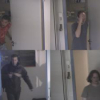Free Online Productivity Tools
i2Speak
i2Symbol
i2OCR
iTex2Img
iWeb2Print
iWeb2Shot
i2Type
iPdf2Split
iPdf2Merge
i2Bopomofo
i2Arabic
i2Style
i2Image
i2PDF
iLatex2Rtf
Sci2ools
ICCV
2007
IEEE
2007
IEEE
Video-based Face Recognition on Real-World Data
In this paper, we present the classification sub-system of a real-time video-based face identification system which recognizes people entering through the door of a laboratory. Since the subjects are not asked to cooperate with the system but are allowed to behave naturally, this application scenario poses many challenges. Continuous, uncontrolled variations of facial appearance due to illumination, pose, expression, and occlusion need to be handled to allow for successful recognition. Faces are classified by a local appearance-based face recognition algorithm. The obtained confidence scores from each classification are progressively combined to provide the identity estimate of the entire sequence. We introduce three different measures to weight the contribution of each individual frame to the overall classification decision. They are distanceto-model (DTM), distance-to-second-closest (DT2ND), and their combination. Both a k-nearest neighbor approach and a set of Gaussian mixtures are...
Computer Vision | Correct Recognition Rates | Face Recognition Algorithm | ICCV 2007 | Individual Frame Scores | K-nearest Neighbor Approach | Video-based Face Identification |
| Added | 14 Oct 2009 |
| Updated | 30 Oct 2009 |
| Type | Conference |
| Year | 2007 |
| Where | ICCV |
| Authors | Johannes Stallkamp, Hazim Kemal Ekenel, Rainer Stiefelhagen |
Comments (0)

